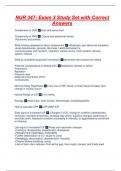NUR 347- Exam 3 Study Set with Correct
Answers
Components of CNS ✅brain and spinal cord
Components of PNS ✅-Cranial and peripheral nerves
-Autonomic and somatic
What is being assessed in Neuro Assessment ✅-Weakness, pain abnormal sensation,
visual disturbances, seizures, dizziness, health/fam/social hx,
-Consciousness and mental fx, cognition, cranial nerves, motor system, sensory
system, reflexes
What is considered purposeful movement ✅Movement that crosses the midline
Potential Complications of Altered LOC ✅Respiratory distress or failure
Pneumonia
Aspiration
Pressure ulcer
Deep vein thrombosis (DVT)
Contractures
Monroe Kelley Hypothesis ✅If any one of CSF, blood, or brain tissue increase, then
change in volume occurs
Normal Range of ICP ✅5-15 mmHg
Etiology ✅Head injury, brain tumors, hemorrhage, encephalopathies
How to calculate CPP ✅CPP=MAP-ICP
Early signs of increased ICP ✅-Changes in LOC, change in condition (restlessness,
confusion, increase drowsiness, increase resp effort), pupillary changes, weakness of
one side (shift), headache-constant, increasing in intensity, or aggravated by movement
or straining
Late signs of increased ICP ✅-Resp and vasomotor changes
-Cushing's- Bradycardia, Hypertension, Bradypnea
-PROJECTILE VOMITING- CONCERN
-Further deterioration of LO- stupor to coma
-Hemiplegia, decortication, decerebration, flaccidity
-Cheyne-Stokes breathing- arrest
-Loss of brain stem reflexes- First will be gag, then cough, corneal, and finally pupil
, What will changing the level of transducer do to fluid in the brain? ✅-Head higher than
drain= increase amount of fluid
-Head lower than drain= decreased amount of fluid
*Pressure gradients must occur SLOWLY
Management of increased ICP ✅osmotic diuretics, restricting fluids, draining CSF,
controlling fever, maintaining systemic BP and oxygenation, reducing cellular metabolic
demands
Cause of Seizures ✅Uncontrolled electrical impulses
Focal Seizures ✅Originates in one hemisphere, involves both motor and non motor s/s
General Seizures ✅Involves both sides of the brain- Motor s/s
Possible causes of seizures ✅-Cerebrovascular disease, hypoxia, fever (childhood),
head injury, HTN, CNS infections, metabolic and toxic conditions, brain tumor,
drug/alcohol withdrawal
Nursing Care of Seizures ✅Time the seizure, observe what they looked like
Ensure loose fitting clothes, seizure pads, O2 and suction
NEVER stick anything in their mouth
Status Epilepticus ✅Constant seizure-Lasts >30 min
-cerebral oxygenation is of concern
Primary cause of headaches ✅No known organic cause and includes migraines,
tension headaches, and cluster HA
Secondary cause of headaches ✅Organic cause like brain tumor/aneurysm
Types of headaches ✅Migraines-Brought on by aura
Cluster- Unilateral, 1-8/day, watering in eye
Tension- Pinch, wrap around the head
*interferes with life/activities
Management of HAs ✅-Dim the lights, decrease noise, ice packs, heat (tension),
massage
Non-Modifiable Risk Factors of CVA ✅->55 yo, men, AA
Modifiable Risk Factors of CVA ✅-HTN(main cause), CV disorder, increase
Cholesterol, obesity, DM, oral contraceptive




